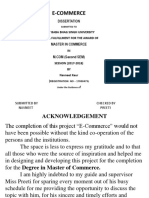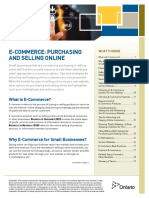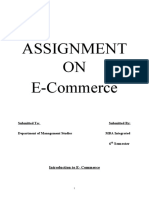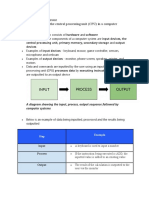UNIT 2: Elements of E-Commerce & M-Commerce
Various elements
Ecommerce or e-business is the process of conducting business transactions between buyers and
sellers through internet enabled computer. The continuous growth of internet technology has changed
the business scenario and most of the sellers and buyers are jumping onto the online bandwagon to
carry out e- business activities. Keeping pace with the changing technology, knowledge of web
languages, search engines, web servers, networking and mode of communications are the basic
aspects of ecommerce.
In this thriving era of digitalization, every ecommerce enterprise should implements dynamic approach
to take their e-business to next level. A robust and comprehensive online marketing strategy can
helps an organization to boost business growth with great ROI and increasing rate of prospective
clients. In order to shine over internet market, a savvy online marketer must have few requisite
components so that they can beat their sturdy competitors.
Online Store
Having an ecommerce website is the most basic aspect of an ecommerce enterprise. An easy to
navigate, well organized and standard ecommerce website can convert a visitor into buyer. Website is
obviously a core of an online enterprise as it is the main platform where customers and buyers can
meet, engage, exchange and transact with each other. A well portrayed website with images and
detailed specification can help the potential buyers to take decision whether to buy the product from
that site or not. You can get an impressive website from your in-house designers or can hire a
professional web design company.
Ecommerce Marketing (Online and Offline)
Marketing and advertising tools can be meticulously utilized to draw attention of prospective buyers to
an online store and helps in converting them into buyers. Currently, SEO (Search Engine Optimization),
PPC- (Pay Per Click), Social platforms such as Facebook, Twitter, LinkedIn and YouTube are abundantly
used as the tools of online advertising and these media played key role in customer retention and
acquisition. Traditional advertising tools such as brochures, hoardings, templates can also help in
motivating customers mind to take positive decisions regarding an online enterprise.
Payment Gateway (Online Transaction)
Payment Gateway is the way of online money transaction while purchasing any product or services
over internet. Initially credit card was the most acceptable mode of online payment. But later, other
means of payment such as PayPal, Net Banking, have been integrated in virtually all e-websites.
Lately, Cash on Delivery has gained immense popularity among online buyers. Other offline modes
such as bank transfer, draft and cheques, etc are also accepted for making payment in ecommerce
website.
Ecommerce Security
Significance of online security system in website is as important as having a security guard in front of a
brick and mortar shop. If your website collects personal information from your customers then it is
imperative to use security systems like SSL (Secure Socket Layer). This secure server software
encrypts all sensitive information and protects the data against unauthorized access and disclosure. By
installing such security system, you can ensure your customers that you are truly concerned about
their private data and its security.
Product Acquisition
Product acquisition is the core segment of an ecommerce organization. This is the basic requirement to
grow an e-business organization or any other traditional organization. Initially, you need to acquire
�products for your business then you can plan out for optimal growth and development of the
organization.
Shipment
It’s the time to process your online order and you need to transit it to the end users. At that moment,
you need a reliable and professional Shipment or logistic service provider who can safely deliver the
product to the customer on time. Failing to meet expectation or deliver on scheduled time can collapse
or damage the business or reputation of any ecommerce enterprise. Thus, Shipment method requires
great discipline and automation in order to maintain higher volume of orders and trust of your
customers.
Supply Chain Management
Supply Chain Management is essential for online players who seek to provide their products and
services to the customer at faster pace and cheaper rate. Supply chain encompasses various activities
like coordination, scheduling, inventory management and the delivery of the product to the end users.
For proper and optimal utilization of resources to deliver ultimate services, the organization needs to
undergo a certain stage of activities which is impossible to handle alone. They must work in
associations with other organizations in their supply chain to achieve complete success.
Warehousing
In online business, warehouse holds important position; this is the place where the organization stores
and maintains their products for further use. Importance of warehouse in ecommerce can be realized
immediately after receiving orders from your customer through online clicks! To have a warehouse,
one should have enough capital to expend on labor, space, equipment and technical information
systems. It plays important role in the supply.
Customer Care Assistance
Customer support is the important aspect of online business as it may win or ruin trust of the buyers.
Seller-buyer relations in online business are incredibly depends on customer support services. High-
quality customer care services can stimulate, inspire and influence a client or customer with its prompt
and class assistance whereas poor customer assistance can holds back ecommerce sales.
Online business nowadays mostly works on these essential elements and all of these ensure smooth
running of your e-business and high business ROI. Once you realize the importance of these aspects,
step forward and build an efficient ecommerce website of your dream and starts to make money
online!
E-Shop
The process of selling and buying products over the internet platform is known as online shopping or e-
shopping.
Benefits of e-shopping are:
Anytime, Anyplace and Any device access
Detailed information about the product along with reviews
Wide range of option along with price
The Advantages of an eShop
In the past decade, e-commerce has evolved tremendously and is competing vigorously with physical
stores in buying and selling.
�An online store is an extremely useful tool in the hands of a business owner. With proper use and
through the use of all its functions it can offer a number of advantages. This will deeply strengthen the
promoted company and thus consolidate its position in the new generation of trade.
24 hour Customer Service
One of the biggest advantages of an eShop compared to a physical store, is that it has no business
hours. Customers can easily and quickly purchase items at any time of the day they wish.
Many people work more than 40 hour per week and it is not uncommon for them to find themselves
with no time for leisure and shopping. There are many cases such as these where modern people have
to resort to online shopping only because the lack of free time. Eshops are often the only solution for
them to procure necessary items as well as other products they might want or need.
24 hours a day, 7 days a week, your eShop will remain open and available for every customer who is
interested in buying your products. Consumers are give the opportunity to make their purchases
unhindered and directly without being limited by time frames.
Global clientele
With an eshop, you can target an expanded clientele regardless of geographical parameters. In a
conventional physical store, the customers come from the respective area in which the store is located.
By building an eShop for your business, this will no longer be a problem for you.
You have the opportunity to promote your products and services worldwide and your success does not
depend on geographical criteria and constraints. With the right development and advertising of your
own online store, you are given the opportunity to gain customers from anywhere in the world. Time
and distance will no longer limit the potential of your online store.
eshop bags and credit card
Product promotion and presentation
The majority of consumers today get informed about the availability of products and services through
the Internet, even if they intend to make a purchase through a physical store.
Imagine how important it is for a company to be able to present its products online. An eShop will
provide the public with an updated list of products daily, so that they can choose whether to visit a
physical store or not. At the same time it provides potential customers with the opportunity to buy the
product they desire directly online.
Easy shopping process
Who can say no to an easy purchase without having to deal with street traffic, weather, crowds and
queues in stores? The answer is obvious to anyone who has ever made a purchase online. This is after
all one of the biggest advantages of eShops that allow eCommerce to flourish through modern and
user friendly platforms.
The 2021 consumer in their incredibly fast paced daily life will undoubtedly choose e-
commerce. Research suggests that e-commerce is the biggest trend and need of our time.
Comfortable, direct, convenient and without any pressure, buying and selling through an eShop is the
solution that thousands of consumers and businesses alike have been waiting for. All you need to do to
attract your online customers is to simply create a user-friendly, fast and functional online store for
your company.
�Advertising / Social Media
One of the most effective ways of gaining traffic and increasing sales is advertising. Just having an
eShop is not enough anymore, you need to take advantage of all the tools the digital media provides
you with. In 2021 an eShop without the proper advertising and social media will be ineffective and
counterproductive.
With promotions based on your products and services, it is possible to reach new consumers and
customers. Depending on what you offer to the sphere of online shopping, you can create different
campaigns aimed at increasing your customer base. At the same time, through platforms that analyze
the movements and behavior of your eShop visitors you can define a target audience and create
specific marketing campaigns. Based on the preferences of your customers you can plan future
discount offers, product combinations at lower prices, coupon codes, and other sales.
Yet another reason any business needs an eShop is that through it you can enhance and more easily
achieve the successful advertising of your brand and products. You are given the opportunity to
promote your company through social media, which the majority of consumers surf daily. Whether it is
Facebook, Instagram, LinkedIn or Twitter, through social media you can build relationships of trust
with your customers, since you can directly interact and communicate with them. You can quickly
answer any questions and reply to their comments establishing a direct line of communication. This
availability and approach demonstrate sincerity and transparency, which consumers value in any
business.
Delivery of goods and services
Today, we cannot think of a world where e-commerce does not exist. E-commerce has evolved and
changed drastically over the years. It has transformed the way we shop, live, work and do business.
With the recent pandemic, we have come to rely and depend on e-commerce for almost everything,
including basic and essential items. The pandemic also saw groups of people who were previously
unused to online shopping turn to e-commerce to fulfill their day to day needs.
This industry continues to grow, and businesses are venturing into this segment and exploring the
benefits it offers. Global e-commerce sales jumped to $26.7 trillion in 2019, four times more than the
previous year, according to data from the UN. This trend is here to stay, with consumers realizing the
convenience of online shopping and home delivery. For small and medium industries, e-commerce
provides access to global markets, wider customer reach and the chance to grow and become
immensely profitable – but only if they are able to put in place an effective delivery mechanism. Orders
must be fast, accurate and delivered without any issues. Merchants either choose to work with
aggregator online marketplaces that have delivery partners in their business ecosystem, or establish
their own online channels, which means they need to put in place their own delivery mechanisms.
E-commerce and e-commerce shipping
E-commerce refers to online shopping or trade, where individuals or firms can buy and sell their goods
and services from a website or mobile app, and have these products delivered to them. E-commerce
shipping is the way in which products ordered online are delivered to the location of the buyer.
Direct to consumer brands now increasingly rely on online channels for sales and managing and
handling the delivery logistics is an important aspect for them to manage. In many cases, logistics and
delivery is not a core competency of the company, and they prefer to partner with an e-commerce
delivery partner to fulfil their orders and deliver these safely to the customer.
E-commerce delivery services usually include:
Inventory and warehousing – e-commerce businesses may not find it feasible to hire their
own warehouses. Logistics companies have the advantage of scale across geographies and can
offer e-commerce businesses a customized network of warehouses with as much or as little
space as they require. They could also scale this as their businesses grow, without the hassle of
� having to find new warehouses or increased space on their own. Several e-commerce logistics
providers have sophisticated inventory management systems that can help businesses to
maintain their supply and demand.
Shipping and delivery of the product – From packing the product as per the unique
specifications and requirements to fulfilling all the documentation and regulatory requirements,
and delivering this to the customer, e-commerce logistics providers play an important role as a
critical business partner. Real-time tracking and quality checks are part of the technology
systems that e-commerce providers have invested in, so that small and medium or even large
companies don’t have to struggle with this. Coordinating with the customer and ensuring that
the product is delivered in time is taken care of by the logistics expert; this is a critical business
activity that is taken care of for the company.
Handling returns and exchanges – Returns are part of the e-commerce business
environment. Consumers may have issues with sizes, wrong orders, or quality-related issues.
Managing returns in a smooth and seamless manner is an important aspect of the customer
journey, strengthening the relationship between the e-commerce company and their customer.
The e-commerce logistics company takes care of the returns aspect, offering online merchants a
full solution for the last mile connection with the customer.
Types of delivery
There is no fixed formula where only a particular type of shipping and delivery system works. Based on
the nature of business, targeted customers, product type, shipping strategies vary. Usually businesses
can work with e-commerce logistics providers to understand what works best for their business.
Companies can expect variations of these:
Two-day shipping
Same day delivery
Overnight shipping
International shipping
Shipping costs are also a factor to be considered, which are usually based on the volumes expected,
destination, size, dimension value of contents. Sometimes e-commerce businesses also offer ‘free
shipping’, and factor this into the product cost.
Delivery in e-commerce is a strategic advantage and drives business success
Logistics companies play an important and vital role in the success of the e-commerce business, as
customer satisfaction is directly related to the handling of the shipment. The packaging and safe
delivery of the product is a factor that keeps the customer happy and ordering more from the e-
commerce site. An e-commerce business needs to have a strong and effective strategy in place for the
shipping and delivery of goods and services, as this is a competitive differentiator as well in the
market.
As e-commerce relies on shipping and transportation, the shipping services should be top-notch –
reliable, knowledgeable and with an extensive network as well as technology-enabled tracking and
monitoring. Responding to this need for efficiency and professionalism, the logistics industry has
evolved its processes, and invested in state-of-the-art delivery systems.
Euromonitor International projects that half of the absolute value growth for the global retail sector will
be digital by 2025, reaching 1.4 trillion USD. With e-commerce here to stay, there is a demand for
efficient, cost-effective and faster delivery alternatives. The e-commerce business relies on e-
commerce logistics to deliver its products. Logistics companies are investing in innovative and smart
technology solutions that integrate human aspects, analyze data for efficiency explore new ways of
�delivering using drones or automated vehicles. For retailers, small businesses and startups, e-
commerce logistics providers have made it all the more easy to enter the market and succeed. All they
need to focus on is a great product and their brand, and the experts will look after e-commerce
delivery.
Internet E-Commerce security,
Security is an essential part of any transaction that takes place over the internet. Customers will lose
his/her faith in e-business if its security is compromised. Following are the essential requirements for
safe e-payments/transactions −
Confidentiality − Information should not be accessible to an unauthorized person. It should
not be intercepted during the transmission.
Integrity − Information should not be altered during its transmission over the network.
Availability − Information should be available wherever and whenever required within a time
limit specified.
Authenticity − There should be a mechanism to authenticate a user before giving him/her an
access to the required information.
Non-Repudiability − It is the protection against the denial of order or denial of payment.
Once a sender sends a message, the sender should not be able to deny sending the message.
Similarly, the recipient of message should not be able to deny the receipt.
Encryption − Information should be encrypted and decrypted only by an authorized user.
Auditability − Data should be recorded in such a way that it can be audited for integrity
requirements.
Measures to ensure Security
Major security measures are following −
Encryption − It is a very effective and practical way to safeguard the data being transmitted
over the network. Sender of the information encrypts the data using a secret code and only the
specified receiver can decrypt the data using the same or a different secret code.
Digital Signature − Digital signature ensures the authenticity of the information. A digital
signature is an e-signature authenticated through encryption and password.
Security Certificates − Security certificate is a unique digital id used to verify the identity of
an individual website or user.
Security Protocols in Internet
We will discuss here some of the popular protocols used over the internet to ensure secured online
transactions.
Secure Socket Layer (SSL)
It is the most commonly used protocol and is widely used across the industry. It meets following
security requirements −
Authentication
Encryption
Integrity
� Non-reputability
"https://" is to be used for HTTP urls with SSL, where as "http:/" is to be used for HTTP urls without
SSL.
Secure Hypertext Transfer Protocol (SHTTP)
SHTTP extends the HTTP internet protocol with public key encryption, authentication, and digital
signature over the internet. Secure HTTP supports multiple security mechanism, providing security to
the end-users. SHTTP works by negotiating encryption scheme types used between the client and the
server.
Secure Electronic Transaction
It is a secure protocol developed by MasterCard and Visa in collaboration. Theoretically, it is the best
security protocol. It has the following components −
Card Holder's Digital Wallet Software − Digital Wallet allows the card holder to make
secure purchases online via point and click interface.
Merchant Software − This software helps merchants to communicate with potential
customers and financial institutions in a secure manner.
Payment Gateway Server Software − Payment gateway provides automatic and standard
payment process. It supports the process for merchant's certificate request.
Certificate Authority Software − This software is used by financial institutions to issue digital
certificates to card holders and merchants, and to enable them to register their account
agreements for secure electronic commerce.
Basics of M-Commerce
M-commerce is growing, roaring, and not showing any signs of slowing down. Actually, it is expected
that the majority of purchases will be made using mobile devices in the coming few years. Given that,
many businesses have already moved to the smartphone platform to boost their revenues, opening
paths for M-Commerce.
It is no hidden fact that almost everyone has a smartphone these days for ease of use, entertainment,
education, and shopping etc. This has made our lives a lot easier. We can do many things on just the
click of a button.
Apps like Google Pay and Apple Pay have revolutionized the way we make payments. It does have its
fair share of drawbacks but still, it is a good option to go after and it’s improving with each passing
day. M-commerce can be used by businesses to improve their customer base and increase their
revenue.
Since they have become our digital ID, we could use it as our wallet. With the robberies not coming to
a stop, it has almost become a headache to carry cash with yourself. Due to this, the need for mobile
wallets or cashless transactions is increasing each passing day. This has lead to a rise in mobile
commerce.
The term Mcommerce has gained popularity over the past few years. The word is used to describe a
digital era that is enabling consumers to make purchases across various digital platforms.
These days, we make purchases not only from brick-and-mortar stores, but also from online
marketplaces, social media, and other digital platforms. But how important is Mcommerce in the grand
scheme of things?
�What is M-Commerce?
M-Commerce, short for Mobile Commerce, is a branch of commerce that deals with the digital
transactions made from the smartphone. It doesn’t require physical contact between two people for
sending or receiving the money.
In other words, we can say that M-commerce (mobile commerce) is the buying and selling of goods
and services through wireless handheld devices such as smartphones and tablets. As a form of e-
commerce, m-commerce enables users to access online shopping platforms without needing to use a
desktop computer.
Examples of M-commerce –
In-app purchasing
Mobile banking
Virtual marketplace apps like the Amazon mobile app or a digital wallet such as Apple Pay,
Android Pay, and Samsung Pay.
Mobile ticketing
Types of M-Commerce
M-commerce can be categorized by function as either mobile shopping, mobile banking or mobile
payments. Mobile shopping allows for a customer to purchase a product from a mobile device, using an
application such as Amazon, or over a web app.
A subcategory of mobile shopping is app commerce, which is a transaction that takes place over
a native app. Mobile banking includes any handheld technology that enables customers to conduct
transactions.
This is typically done through a secure, dedicated app provided by the banking institution. Mobile
payments enable users to buy products using a mobile device. Digital wallets, such as Apple Pay, allow
a customer to buy a product without needing to swipe a card or pay with physical cash.
The different types of Mobile Commerce are-
1. Browsing for stuff online on your mobile – This type deals with surfing for stuff online like
looking for Groceries, Daily essentials, and electronics. We’re talking about dedicated apps, optimized
websites, or even social media platforms like Facebook or Instagram that allow in-app purchases or
linking to online stores.
2. Purchasing app-delivery stuff (Food delivery or e-commerce apps) – This type deals with the
services related to ordering things like food, cab pickup, and others.
3. Mobile banking – Mobile banking is the method that involves accessing the features of the bank
using online methods. The transactions are made from specific apps designed by apps, though some
financial services companies are now experimenting with chatbots or messaging apps to deliver
customer service.
4. Mobile App payments(Google Pay or PayPal) – This type primarily focuses on making payment
transactions through apps. The user is required to register their credit or debit card and then use it
whenever they want.
5. Purchasing or renting digital content (Netflix, Spotify, etc) on a mobile device – This
involves buying or renting online services like Music Streaming, Video Streaming, or commodity-based
on a rent basis.
�6. Mobile person-to-person payments(Venmo or Xoom) – This type involves sending money from
one person to another, be it for buying stuff or sending it to someone in need. This type of transaction
can be made by sending money to someone’s number or to their bank account directly.
Advantages of mobile commerce(mCommerce)
#1. Provides Easy Store Access
MCommerce makes easy to discover the products available in the market by utilizing wireless devices.
With mobile commerce, customers need not travel to the store to purchase their needs, rather, they
can buy their products online. So, this decreases their effort, money and saves their time. In addition,
one of the advantages of mobile commerce is that you can continually make updates and deliver your
eCommerce site better than ever before.
#2. Better User Experience
User experience really matters in eCommerce. Today, people are well familiar with how smartphones
and tablets work. And the customers are already know how to navigate to desired products in several
clicks. Additionally, the customers sharing their enjoyment of acquired goods with friends, or request
for advice from a community of compulsive shoppers. Therefore, a smooth user experience equals
better conversion rates & income.
To succeed in your eCommerce business, your mobile app should be:
Fast
Convenient
Interactive
Exclusive
#3. Creates a New Marketing Channel
Including, another advantage of mobile commerce is that you build a new marketing channel. Using
mobile apps, you can quickly sell your goods and products to end-users. Besides, it serves multiple
functionalities such as it can give general information, search features, news feeds, product prices, and
so on. Although, one of the biggest advantages of having a mobile app for your business is that all the
information you like to provide your clients is available at their fingertips. This involves special sales
and promotions. By push notifications, you can become even closer to a direct interaction with your
buyers. So, you can easily remind your consumers about your products & services whenever needed.
#4. Location Tracking & Personalized Notifications
Location tracking can benefit from providing assistance to consumers in navigating directions or
helping them discover the expected transportation service, etc. Therefore, once a client subscribes to
your brand, you can send them location-based push notifications with personalized discounts and
increase your sales. This brings in a greater possibility of easy conversions. According to the research
by Responsys, the personalized push notifications are liked by people & provide with two times higher
conversion rates as related to the ones made by marketing emails.
#5. Benefits with Traditional Retail Sales
One of the main advantages of mobile commerce is that it can assist with traditional retail sales.
Remember, how a retail store would look if it had thoroughly all the aspects of products that are
accessible. Not only would it be a trouble for staffs who have to manually update that data, however, it
would be cluttered and clumsy for everyone from the staffs to the customers to have to purchase.
Hence, mobile commerce is growing and it will continue to evolve, taking a more leading place in the
retail trades.
�#6. Cost Reduction and Productivity
Through reaching your customer faster with a mobile app you certainly reduce marketing campaign
expenses. So, the mobile apps decrease the costs of SMS messages, paper newsletters, and brochure.
If your eCommerce app has social commerce integration, customers will do their part too in spreading
the word. Besides, you can earn from placing ads within your app later on. It also simplifies client
communications by utilizing secured, instant and direct messages. Moreover, it has cut down the crew
workload as they don’t have to send information requests and phone calls anymore.
#7. Attracts New Consumers
In eCommerce, there is always the potential to bring in new consumers. An optimized eCommerce
website is not just one that holds your existing customer base, but it’s also one that attracts new
buyers who come over your online store and find it appealing. Besides, mobile searches are one of the
essential ways that consumers are going to discover your website and the higher the chances are that
you will get more business.
Additionally, mobile re-targeting, which displays ads to those who have recently visited your
eCommerce website to attract them to go back and buy items they looked at, can be a hugely helpful
tool for your business.
#8. Higher ROI
According to the research by Google, 67 % of people said they would be more probably to purchase
from a mobile-friendly eCommerce site, and 61% said that a website that was not mobile-friendly
would make them want to move away. So, your products converse for themselves, although word-of-
mouth can be a robust tool. When a consumer wanders about a product & how great of a purchasing
experience they held, and that’s really free marketing for you. Despite, an order from one consumer
could already pay you back for the time & money you paid on upgrading your eCommerce site.




















































































































